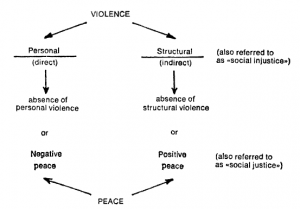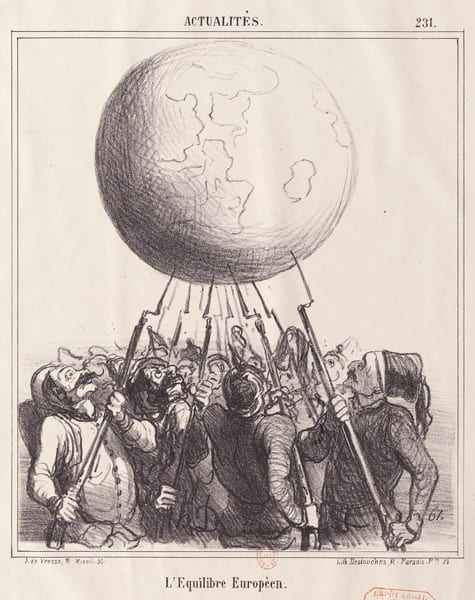Peace
Excerpts from 'Peace: A History of Movements and Ideas'; David Cortright, Cambridge University Press 2008.
Peace in its simplest characterization indicates an absence of conflict - especially violent conflict - while more proactive definitions include an active presence of positive states of being, such as justice, equality, free expression, physical health and safety, and self-actualization. When put into practice, the meanings of peace and what its pursuit entails vary significantly according to worldview and circumstance. The term is highly emotive, and is often abused as a tool of political propaganda. When peace is defined narrowly it can imply passivity and the acceptance of injustice. Peace is more than the absence of war. It is also the maintenance of an orderly and just society – orderly in being protected against the violence or extortion of aggressors, and just in being defended against exploitation and abuse by the more powerful. Many writers distinguish between negative peace, which is simply the absence of war, and positive peace, which is the presence of justice. Genuine peace means progress toward a freer and more just world. Johan Galtung developed the concept of “ structural violence ” to describe situations of negative peace that have violent and unjust consequences. Violence in Galtung ’ s expansive definition is any condition that prevents a human being from achieving her or his full potential. Leonardo Boff, the Brazilian priest and theologian, employed the term “ originating violence, ” which he defined as an oppressive social condition that preserves the interests of the elite over the needs of dispossessed and marginalized populations. Positive peace thus means transcending the conditions that limit human potential and assuring opportunities for self realization.
Mahatma Gandhi spoke of nonviolence rather than peace and emphasized the necessity of overcoming injustice. Gandhi's meaning was deftly summarized by Jonathan Schell: “ Violence is a method by which the ruthless few can subdue the passive many. Nonviolence is a means by which the active many can overcome the ruthless few. ” Yet the word nonviolence is “ highly imperfect, ” wrote Schell. It is a word of “ negative construction, ” as if the most important thing that can be said about nonviolence is that it is not something else. Schell attempted to resolve this dilemma by defining nonviolence as “ cooperative power ”– collective action based on mutual consent, in contrast to coercive power, which compels action through the threat or use of force.
Further, peace researcher and former Australian ambassador John W. Burton argues that peace must not necessarily mean the absence of conflict. Conflict is intrinsic in human relationships, although it does not have to be and usually is not violent. The challenge for peace practitioners is to find ways in which communities can resolve differences without physical violence. In this context peace is understood as a dynamic process not an absolute end point. The goal of peacemakers is to develop more effective ways of resolving disputes without violent conflict, to identify and transform the conditions that cause war.
Pacifism
Pacifism existed as a movement and set of ideas long before the actual word was coined in 1901 . The term emerged during the tenth Universal Peace Congress in Glasgow, at a time when organizations seeking to prevent war were spreading throughout Europe and the United States. Proposals for arbitration and the development of international law were gaining support among political leaders on both sides of the Atlantic. Bertha von Suttner ’ s book Lay Down Your Weapons was an international bestseller, published in thirty-seven editions and translated into more than a dozen languages. The ideology of the peace movement was maturing. The narrow religious base of the early Anglo-American peace societies was giving way to more secular, humanitarian perspectives, especially in continental Europe. Prior to the Glasgow congress members of the various peace societies and international organizations generally referred to themselves as “ peace workers, ”“ peace advocates, ” or, most commonly, “ friends of peace. ” Activists sought to develop a better term that would more effectively convey the growing maturity and sophistication of the movement.
It was Émile Arnaud of France, president of the Ligue internationale de la paix et de la liberté, who first introduced the word “ pacifism. ” It was meant to suggest a coherent body of thought and developed set of political beliefs and policies for preventing war and assuring peace. The term was officially adopted at the Glasgow congress. Thereafter those who participated in the various peace organizations and societies around the world began to refer to themselves as “ pacifists. ” It was a term of distinction and had a broad social connotation. It was meant to encompass all of those who worked to preserve peace and prevent war.
Arnaud sought to distinguish pacifists from those who merely hope or pray for peace. “ We are not passive types . . . we are pacifists. ” Pacifism included a personal commitment to take action, to work for peace. It implied, historian Roger Chickering wrote, a “ high degree of engagement in activity ” to help reduce the level of violence in international relations. The study of peace is thus a history of social action as well as of ideas, an examination of social movements and of intellectual development.
Debate over pacifism in theory and in practice came to a head with the outbreak of war in 1914 , when the peace movement collapsed and fractured. Most peace advocates, including internationalists and socialists, abandoned their commitment to transnational solidarity and marched off to war. In the years after World War I there was much recrimination and debate about the meaning of pacifism. The purists who had opposed the march to war claimed the term for themselves. They narrowed its definition to the unconditional rejection of war in all its forms. The restrictive meaning of pacifism became the accepted standard and became the standard in both scholarly and popular discourse.
Many of those who considered themselves pacifist were uncomfortable with the absolutist stand. As the menace of fascism mounted in the 1930's, pacifism became increasingly marginalized and associated with isolationism. The term sank into disrepute and was largely abandoned, even by those who considered themselves advocates of peace. Some tried to redefine pacifism to include rearmament and collective military resistance against Hitler. Others adopted a “ peace with justice ” perspective, arguing that the prevention of war depended on resolving political and economic grievances. They were part of a broad social movement amorphously defined as for peace, but they lacked a coherent program for preventing the impending war and had no commonly accepted “ ism ” to describe the prevailing philosophy.
Scholars attempted to remedy this frustrating imprecision by providing definitions for the various philosophies and political tendencies that exist within the peace community. The most elaborate and sophisticated attempt to parse the meaning of pacifism was provided by historian Martin Ceadel in his masterful volume, Thinking about Peace and War. Ceadel identified five distinct theories of war and peace, ranging from militarism to pacifism. He differentiated absolute pacifism from “ pacificism. ” The latter term was coined by the historian A.J.P. Taylor to describe those who believe that war is always irrational and inhumane and should be prevented, but who accept that it may be necessary at times. Ceadel defined pacificists as those who believe that war can be prevented and with sufficient commitment to justice can be abolished, or nearly so.
Pacifism and 'Just War'
Pacifism and the just war tradition are analytically distinct and are often considered opposites. The concept of pragmatic pacifism helps to bridge the gap and provides a more holistic framework for understanding peace advocacy. It reflects the dominant position of those who consider themselves peace supporters. Absolute pacifists have always been a minority, even within peace movements. The majority of those who work for peace seek to avoid war but are willing to accept some limited use of force for self-defense or to uphold justice and protect the innocent. Some uses of military force are more objectionable than others. This is evident from the fact that certain wars, such as those in Vietnam and Iraq, inspired vociferous movements of mass protest, while other uses of force, such as the multinational operation in Bosnia, were broadly accepted, even by many peace supporters. Because just war language is often abused by political leaders to justify military aggression there is concern that misuse of the framework can be a slippery slope toward the legitimation of indiscriminate violence. As Michael Walzer emphasized, just war reasoning is a challenge to political realism. 36 The just war doctrine establishes a rigorous set of moral conditions that must be met before armed conflict can be considered. If thoroughly and honestly applied these criteria would rule out most of the armed conflicts that political leaders claim to be just and would make war a rare occurrence.
Pragmatic pacifism can be understood as a continuum of perspectives, beginning on one end with the rejection of military violence and extending across a range of options that allow for some limited use of force under specific conditions. The just war position also contains a continuum of perspectives, extending from limited police action to all-out war, based on a set of moral criteria that can vary significantly in different settings. Views on whether a particular use of force is justified range from a restrictive interpretation that permits military action only under narrowly constrained circumstances, to more expansive claims that seek to justify large-scale military operations and even the unprovoked invasion of other countries. The continuum of pacifism can be combined with that of just war to form a continuous range of options extending from absolute nonviolence at the one end to the justification of war at the other. All the differing perspectives on war and peace thus can be considered in relation to one another. This is the approach employed by Ceadel in his classification of five major perspectives on peace and war.
An honest appraisal of war through the lens of just war criteria would forbid any consideration of nuclear strikes and would rule out virtually all forms of large-scale, unilateral military intervention. It would leave only self-defense and limited, legally constrained uses of multilateral force to protect civilians and restore conditions of justice. The “ responsibility to protect ” principles that have recently gained international endorsement embody this perspective.
Peace Studies
Peace Studies is a social science field that identifies and analyzes violent and nonviolent behaviors as well as the structural mechanisms attending conflicts (including social conflicts), with a view towards understanding those processes which lead to a more desirable human condition. A variation on this, peace studies (irenology), is an interdisciplinary effort aiming at the prevention, de-escalation, and solution of conflicts by peaceful means, thereby seeking "victory" for all parties involved in the conflict.
This social science is in contrast to military studies, which has as its aim on the efficient attainment of victory in conflicts, primarily by violent means to the satisfaction of one or more, but not all, parties involved. Disciplines involved may include philosophy, political science, geography, economics, psychology, sociology, international relations, history, anthropology, religious studies, and gender studies, as well as a variety of others. Relevant sub-disciplines of such fields, such as peace economics, may be regarded as belonging to peace and conflict studies also.
Peace studies intersects heavily with international relations theory, which seeks to explain relationships between nation-states and similar polities. The core of international relations theory was formulated in the early-to-mid 20th century, a time when consolidated and organized states and governments were considered the primary agents of activity. Consequently, international relations theory does not always offer appropriate explanations for peace and conflict between individuals, communities, and identity groups.






